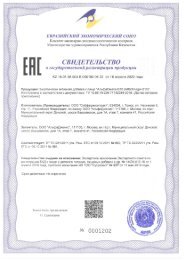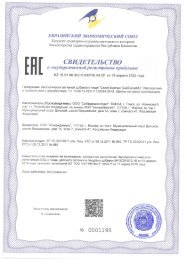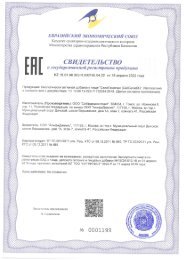Metafoodbiom AGenYZ (en)
Create successful ePaper yourself
Turn your PDF publications into a flip-book with our unique Google optimized e-Paper software.
MetaFoodBiom
to normalize gut microbiota
MetaFoodBiom
Microbiome, microbiota, microflora
The human microbiome is a collection of micro-organisms that live in
the human body, including bacteria, fungi, viruses, and protozoa.
The term was first proposed by an American geneticist in 2001.
Each microbiome contains its own communities, which are called
"microbiota".
There are microbiota of the gut, mouth, skin and other organs, and
each mini-ecosystem differs from one part of the body to another.
For example, the composition of bacteria on the left and right feet
will be different.
The terms "microbiome" and "microbiota" are often used
interchangeably. Previously, the more commonly used term was
"microflora", but this is an outdated term, as flora refers to the plant
life, whereas "biota" refers to the collection of microorganisms in the
living world."
MetaFoodBiom
Different
diets
§ The gut microbiome consists of
over 3 million genes. 1/3 of the
human gut microbiota is common to
most people.
Different gut
microbiome >
different
metabolites
§ 2/3 are individual and create a
unique "identity card"
Different health
status
The composition of an adult's
microbiota depends on various
factors: genetics, mode of delivery,
sex, age, height, diet, sleep, chronic
diseases, bad habits, medications
taken, living conditions.
MetaFoodBiom
The number of micro-organisms in the gut exceeds the total
number of all cells in the human body.
The total mass of gut microbiota ranges from 1 to 3 kg.
An adult weighing 70 kg and height 170 cm contains
around 30 trillion cells and 49 trillion gut bacteria.
Microbiota is an ecosystem dominated by bacteria, mainly strict
anaerobes that do not need oxygen to live. It also contains other
micro-organisms: viruses and bacteriophages, protozoa, archaea
(unicellular living organisms) and fungi. In total there are over
7,000 strains in the microbiota. The gut makes up 2/3 of the
immune system.
According to scientists, each gut cell of an adult provides nutrients to 100,000
other cells in the body.
MetaFoodBiom
The microbiota of children
changes from 0 to 3 years old
Gut microbiome in infants
The microbiota changes until adulthood,
then stabilises
Gut microbiome in adults
As we get older, the microbiota
becomes depleted
Gut microbiome in elderly
The newborn inherits the bacteria from the
mother, especially during natural childbirth
and breastfeeding.
During the first hours and days, the
intestines of newborns are predominantly
infected with micrococci, staphylococci,
enterococci and clostridia, followed by
enterobacteria, lactobacilli and
bifidobacteria.
The adult microbiome is fully formed
and is characterised by a rich and
diverse bacteria.
In adults, the gut microbiome is
relatively stable, but largely
depends on lifestyle.
The intestinal microbiota of the
elderly is characterised by lower
diversity, with domination of certain
species and a decrease in the number
of beneficial microorganisms, such as
lactobacilli and bifidobacteria.
MetaFoodBiom
3 types of bacteria in the
gut microbiome
Friendly bacteria - they help your immune
system respond quickly to pathogens,
without giving them a chance to multiply
and displace the beneficial inhabitants of
the gut.
Friendly
Lactobacillus
Bifidobacteria
Conditionally pathogenic bacteria - are
usually harmless to a healthy person. But
they multiply dramatically when the body is
negatively affected. If a person is injured,
their immune system fails or their microbiota
is out of balance, neutral microbes can
become pathogenic.
Conditionally pathogenic
Pathogenic
Escherichia coli
Clostridia
Enterococci
Pathogenic bacteria - can cause illness, but only if their
numbers are too high or they have entered the body with a
weakened immune defence.
Campylobacter
MetaFoodBiom
Composition of the healthy gut microbiota:
All microorganisms that normally inhabit the
large intestine are divided into three groups:
1. The main ones (lactobacilli, bifidobacteria and
bacteroides),
2. Companion (E. coli, enterococci),
3. Final (staphylococci, fungi, protozoa).
MetaFoodBiom
Functions of the
microbiota
A state of equilibrium between
microbiota populations is
characteristic of complete health and
the maintenance of a constant internal
environment of the macroorganism,
members of the microbiota are
involved in almost all metabolic
processes.
A normally functioning microbiota should have the following
effects:
1. Prevent colonisation of the
gastrointestinal tract by
pathogenic microorganisms
2. Promote local and systemic
immunity
3. Utilise unabsorbed nutriens
in the small intestine,
regulating energy
expenditure and storage
4. Participate in the regulation
of gastrointestinal motility
5. Synthesise B vitamins, vitamin
K, biologically active and
hormone-like substances
6. Regulate cholesterol
metabolism, oxalate
metabolism, absorption of
calcium and other ions
7. Protect mucosa and distant
organs from damaging effects
of toxins, xenobiotics and procarcinogens
by utilising and
metabolising them
MetaFoodBiom
The gut microbiota affects not only the physical,
but also psychological well-being of a person.
The term "psychobiotic" has already been appeared, which refers to living
microorganisms. The intake of psychobiotics has a beneficial effect on the health of
patients with mental illness.
Scientists have been able to prove that, in addition to mood, active and beneficial gut
bacteria also affect the level of susceptibility to stress and anxiety.
A balanced microbiota can help cope with these pressures on mental health.
According to the results of
the study: after 4 weeks of
taking a cocktail of various
beneficial bacteria,
significant changes were
observed in certain areas of
the brain, primarily in areas
that are responsible for
emotions, feelings and pain
perception.
§ E. coli can secrete dopamine, serotonin and
norepinephrine;
§ Lactobacilli produce serotonin, GABA,
acetylcholine and histamine;
§ Bifidobacteria affect central serotonin
transmission;
§ E. coli, Bacillus and Saccharomyces spp. can
produce noradrenaline;
In this way, probiotics help to
combat stress and the ageing
process associated with it.
§ Streptococci and enterococci synthesise
serotonin;
§ Bacillus can produce dopamine.
MetaFoodBiom
Disturbance of the gut microbiota – dysbiosis is a
condition in which the balance between beneficial gut
bacteria (such as bifidobacteria and lactobacilli) and
pathogenic bacteria (Klebsiella, Proteus,
Enterobacteriaceae, etc.) is disrupted.
The altered composition of the microbiota affects the intestinal
immune system. The immunity activated by gut dysbiosis triggers
a cascade of inflammatory reactions, leading to joint damage, skin
problems, kidney damage, gastrointestinal issues, and more. If the
defence response is excessive, autoimmune diseases develop.
Dysbiosis is not a disease, but it underlies many
conditions including intestinal, systemic
inflammatory, autoimmune and neuropsychiatric
disorders.
Pathogenic bacteria can be activated
when the immune system is weakened,
during frequent stress, poor diet or
exacerbations of gastrointestinal
diseases.
MetaFoodBiom
The disruption of the gut microbiota is
manifested in the form of
§ Impaired gastrointestinal function, which
leads to abdominal bloating, alternating
constipation and diarrhoea, abdominal
pain, etc.
§ Unexpected allergic reactions to certain
foods, accompanied by nausea, vomiting,
diarrhoea, skin itching, rashes, etc.
§ Impaired nutrient absorption, leading to
iron and vitamin deficiencies, weakened
immunity.
§ Complaints of weakness,
headaches, lack of appetite
§ Anxiety and depression
§ Inflammatory processes
§ Skin irritation, dull hairand
nails
§ Changes in weight
§ Bad breath
§ Cravings for alcohol or sweets
MetaFoodBiom
The main causes of disruption of the gut
microbiota include:
§ Eating on the go, fast food consumption,
eating in a hurry without proper focus on the
meal
§ Uncontrolled intake of medications, such as
antibiotics, which affect both pathogenic and
"beneficial" gut bacteria
§ Incorrect diet, including monotonous food
consumption
§ Impaired gastrointestinal motility
§ Uncontrolled adherence to diets
§ Gastrointestinal infections
§ Chronic gastrointestinal diseases
(gastritis, enteritis, colitis, etc.)
§ Endocrine disorders
§ Allergic diseases
§ Stress and depression
§ Alcohol consumption , smoking
§ Climatic and environmental
conditions
§ Chemotherapy and radiotherapy for
cancer.
MetaFoodBiom
Diseases associated with disorders of the gut
microbiota:
§ autoimmune hepatitis;
§ fatty hepatosis;
§ insulin resistance;
§ type 2 diabetes;
§ obesity;
§ bacterial overgrowth syndrome (SIBO)
§ irritable bowel syndrome;
§ IBD: Chron’s disease, ulcerative colitis;
§ celiac disease;
§ bronchial asthma;
§ multiple sclerosis;
§ autism;
§ attention deficit hyperactivity
disorder (ADHD);
§ alzheimer’s disease;
§ depression;
§ parkinson’s disease;
§ cognitive impairment.
§ colon cancer;
MetaFoodBiom
Gut-brain interactions
Alzheimer's disease
Autism
multiple sclerosis
Depression
Parkinson's disease
Increased BBB permeability
Systemic inflammation
Intestinal permeability
Bacterial amyloid
LPS (Lipopolysaccharide)
Stress
infections
Diet
antibiotics
MetaFoodBiom
The key to creating and managing a healthy gut
microbiota is regulating the balance between
beneficial and pathogenic microorganisms.
Diet plays a crucial role, not only by providing a
balanced intake of energy, but also supplying
certain nutrients that directly affect the
composition of the microbiota.
The addition of prebiotics is essential for optimal
gut microbiota function.
The positive effects of prebiotics on microbiota
growth and activity are well studied, including
their ability to nourish beneficial commensal
bacteria while helping to inhibit harmful ones.
Natural enzyme preparations are also
important, as they help break down food in the
digestive tract into small particles – cobiotics.
These are what bacteria and cells in the human
gut feed on.
MetaFoodBiom
Three simple rules to revitalise your
gut microbiome
1. Always chew your food
thoroughly!
2. Eat in a calm state, not
when you are tired and
stressed, and not when
your hands and feet are
cold (because then the
blood supply to your gut
will be poor).
3. Eat only when you feel
hungry.
Important!
If you decide to change your
eating habits, you should not do
so abruptly and immediately
switch to new foods.
A sudden change in diet will
confuse the bacteria in your gut
and this can lead to bloating and
increased gas production.
The amount of new foods
(including nutrients in the form
of fruit and vegetables) in your
diet should be increased
gradually.
MetaFoodBiom
MetaFoodBiom
Composition
Kombucha
concentrate
17 strains peptide
ultralysates
Acacia gum
(gum arabic)
Guar and xanthan
gum
Lactic acid
Enzymes: lysozyme,
muromidase, bromelain
BAS from Bacillus
subtilus
Zeolite
Licorice extract
Fulvic and humic acids
MetaFoodBiom
Composition of MetaFoodBiom
Kombucha concentrate
Kombucha is a natural probiotic product obtained by
fermentating tea with symbiotic microorganisms such as
Komagataeibacter bacteria, Acetobacter xylinum and
Zygosaccharomyces fungi (>7 species). It is known as the
'Elixir of Immortality'.
The unique property of kombucha is its ability to inhibit
glycation processes. As a result of glycation, collagen and
elastin molecules are damaged, causing the skin to lose its
elasticity, thin out, and sag, leading to the appearance of
wrinkles. When kombucha is used, glycation decreases by
79%!
In vitro, it has antimicrobial activity against Helicobacter
pylori (the main cause of gastritis and peptic ulcers), E. coli,
Staphylococcus aureus and Agrobacterium.
Kombucha restores gut microbiota. It helps
normalize the pH in the intestinal lumen and
promotes active regeneration of intestinal
epithelial cells.
MetaFoodBiom
Composition of MetaFoodBiom
Metabiotics (Peptide
ultralysates) of 17 strains
(6 strains of Bifidobacterium and 11 strains of Lactobacillus) are
products resulting from the breakdown of probiotic bacterial
cells into fragments that include fragments of the bacterial cell
wall and their intracellular content.
§ Does not break down in the stomach and reaches the
intestines, acting quickly
§ Safe and suitable for consumers with unbalanced or
compromised immune system who cannot use live
probiotics
§ Can be used in high doses
§ Have a long shelf life
Metabiotics provide the body with ready-made
metabolically active substances that healthy
person's microbiota should normally produce.
MetaFoodBiom
Composition of MetaFoodBiom
Postbiotic metafiltrate contains:
§ Zeolite mineral,
§ Muromidase enzyme - an antibacterial agent
that destroys bacterial cell walls
§ A complex of biologically active substances
released by Bacillus subtilus, which inhibit
pathogenic and opportunistic micro-organisms
and destroy the beta-glucans of the cell wall of
Candida Albicans.
The sorption properties of zeolite are
necessary for binding and removing
bacterial and food toxins.
MetaFoodBiom
Composition of MetaFoodBiom
Lactic acid - a natural metabolite of lactic acid
bacteria that creates favourable conditions for the
development of its own microflora.
Lysozyme - is an enzyme that breaks down the cell
walls of pathogenic bacteria.
Lysozyme - is a proteolytic enzyme called
muramidase, synthesized by macrophages,
neutrophils and other phagocytic cells and
constantly present in the body fluids and tissues. It
is found in blood, lymph, tears, milk, semen,
genitourinary tract, mucous membranes of the
respiratory and gastrointestinal tract, and in the
brain.
Non-digestible fibres - (Acacia gum) - provides extra
protection and nourishment for normal intestinal
microbiota.
Guar gum - is produced from the culture of guar
beans which contain up to 70% culture, a bean that
contains up to 70% valuable resin.
Xanthan gum - is obtained from the fermentation
reaction of microorganisms Xanthomonas
campestris. It reduces blood sugar levels after meals!
Licorice extract - enhances the effect of other
ingredients and their anti-inflammatory action. It has
a detox effect.
MetaFoodBiom
Composition of MetaFoodBiom
Bromelain
Bromelain - is a naturally
occurring proteolytic enzyme:
§ Helps to reduce chronic
inflammation
§ Speeds up the regeneration
of the intestinal mucosa
Bromelain - is derived
from pineapple, where it's
found in high concentrations in
the solid part of the fruit.
Bromelain has a wide range of action:
§ Increases enzymatic activity
§ Helps the body to break down and
absorb protein foods
§ Normalizes metabolism
§ Also has the ability to break down
fats and reduce the contamination
of the body with toxins
§ Has anti-inflammatory and healing
properties
§ Gently reduces blood clotting.
MetaFoodBiom
Composition of MetaFoodBiom
Fulvic and humic acids
Considered to be one of the
best natural detoxifiers.
Cleanse the body of toxins,
cholesterol and remove
allergens.
Fulvic acid acts as a conductor for
vitamins and minerals and
enhances their bioavailability at
the cellular level to 98%, compared
to the typical 40-50%.
They normalize digestion and
peristalsis, enhance immunity.
Humic acids are selective prebiotics
and improve the growth of bifidogenic
flora.
MetaFoodBiom
The enteric coating of the
MetaFoodBiom capsule
ensures targeted delivery of
the ingredients into the
intestines.
The enzymes in the product
need an alkaline environment in
the intestines in order for them
to take full effect.
The stomach has an acidic
environment - it can neutralise
the activity of proteolytic
enzymes.
Therefore, acid-resistant
capsules are preferred.
MetaFoodBiom
The functions of the
complex:
Recommended when:
§ Reducing inflammatory
reactions in the
gastrointestinal tract
§ Intestinal epithelium
regeneration
§ Digestive health
atopic
dermatitis
allergies
and other
manifestations
acne
§ Detoxification
§ Improving the intestinal
microflora
§ Restore water-electrolyte
balance in the intestine
§ Normalization of natural
vitamin B and K synthesis
problems with
the intestine
and skin
in case of
alcoholic and
food poisonings
gastrointestinal
disorders
MetaFoodBiom
Advantages and bioinnovations of
MetaFoodBiom
§ Probiotic organisms grown using
innovative methods, high fragmentation
of bacterial walls
§ Large diversity of microbial strains - >20!
§ Most effective components for gut
microbiota
§ Enzymes that protect against pathogenic
bacteria
§ Metabolic detoxification
§ Increased effectiveness of components
due to synergy
MetaFoodBiom
How to use MetaFoodBiom
1. Preventative use:
Take 1 capsule twice a day after meals.
2. After poisoning
Take 2 capsules in the morning on an empty
stomach.
The recommended minimum course is 2 months.
DO NOT open the capsule
with an enteric coating!














